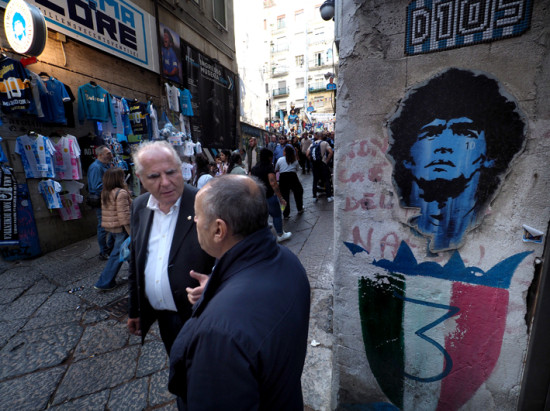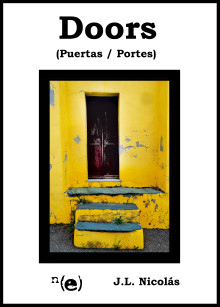Napule, Napule
“Il nome, il simplice nome di Napoli è uno dei più carichi di forza imaginativa che siano al mondo"
From the air, or alternatively from the heights of Castel Sant'Elmo, the view of the gulf's waters confirms Naples' role as a gateway to the Tyrrhenian Sea, always with the unmistakable silhouette of Mount Vesuvius in the background. Read more See the pictures
The Tyrrhenian Sea
“The Tyrrhenian Sea” is a small preview of the upcoming book, in the Travel Diaries series, dedicated to the smaller islands of this sea, and in fact, its first chapter. While another book, “Four Islands,” covered the larger islands —Sicily, Sardinia, and Corsica — this one focuses on the smaller archipelagos. The Tuscan one, with Elba, famous for Napoleon's exile; the Aeolian Islands, the result of the ill temper of a subterranean god angry with the world, Hephaestus, which here has manifested in numerous volcanic eruptions and earthquakes that have, more than once, altered the physical and human landscape of some areas, particularly near Mount Etna or Stromboli; the Aegadian Islands, at the westernmost tip of Sicily; the lonely Ustica; the islands of the Gulf of Naples, which form a myriad of rugged and also gentle landscapes, especially on the renowned Capri; and the small Pontine Islands, halfway between Naples and Rome. Places you always long to return to. Read more See the pictures

Maillol in Banyuls
In 1861 Banyuls de la Marenda, in Roussillon, saw the birth of sculptor Aristide Maillol, one of the most representative of the 20th century, who at the age of twenty moved, like so many others, to Paris. When he returned to his native land, in 1910, he settled on a farm in the Roume Valley, on the outskirts of the town. Currently the house has become a museum dedicated to his work, where some designs, drawings and, of course, statues are exhibited. Read more See the pictures
The Farnese Collection
The Museo Archeologico Nazionale di Napoli (MANN) preserves and exhibits one of the largest collections of ancient sculpture that was formed during the Renaissance, linked to the family of Alessandro Farnese (1468-1549) who was Pope Paul III and his nephews, the dukes of Parma. Read more See the pictures
Around the Zuider Zee
The Zuider Zee, the South Sea, was a vast, shallow water inlet of the North Sea in the middle of the Netherlands. In 1932 this inland sea was enclosed by a dike of pharaonic dimensions, the Afsluitdijk, since then regulates the marine flow between both sides. Above, a highway runs through almost twenty miles splitting North Holland and Friesland provinces. Read more See the pictures
Aphrodite in Milos
If there is one thing that made the island of Milos, in the south-west of the Cyclades, famous, it was the discovery of an extraordinary statue that ended up on display in room 346 of the Sully Wing of the Louvre Museum in Paris: the Venus de Milo. Read more See the pictures
Happy New Year 2025
To the 581.0180 readers that have visited 1.636.122 pages along this 2024 now over.
Thanks to everybody for your time and we hope 2025 will be a greater and better year for everyone. Cheers!

Two Deserted Villages
The depopulation of rural areas is usually due to the search of work and better living conditions. It was a constant after the industrial revolution, but in these two cases, Belchite and Jánovas, in Spain, the reasons were completely different but they got common elements: the civil war and human greed. Read more See the pictures
A Square in Plaka
Filomousou Etaireias is a popular square in the centre of Athens, also known as the Plaka Square, which, despite Lonely Planet's reputation as touristy in the extreme, is a pleasant place with curious details. Read more See the pictures
Spanish Armada Castaways
Spanish King Philip II said he had sent his ships to fight the British not the elements. And he was right. Just battled against the British a few skirmishes in the English Channel and had a little bit more than words in Gravelines, but nothing serious for the Spanish fleet. The truth is that the main objective was to transfer the Flanders troops to Britain and this was not achieved. The odyssey begun homeward bound. Read more See the pictures
Procida, Italy
It is the smallest of the islands in the Gulf of Naples, less than four square kilometres, and is located halfway between the city and the island of Ischia. The third is the famous Capri, further south. According to Pliny and Strabo, Procida was separated from the mainland because of a great earthquake that took place during the eruption of Mount Epomeo, in Ischia. Read more See the pictures
Rome Keats' House
John Keats was a contemporary of Percy Bysshe Shelley and Lord Byron, with whom he embodied the second wave of British romantic poets in the wake of Samuel Taylor Coleridge and William Wordsworth. The house where Keats lived in Rome was threatened with demolition but English and American diplomats promoted the project to maintain the house as a museum dedicated to the poet. Titled the Keats-Shelley Memorial House, it opened in April 1909. Read more See the pictures
Cologne Gateways
Since Roman times, Cologne had strong walls to ensure the defence of the city. Later, in medieval age, new walls and gates were built, some of these have survived to this day. Read more See the pictures
Conques, in Aveyron
The small town of Conques, in the former province of Rourge and a few kilometres away from the Lot Valley, today between the departments of Cantal and Aveyron, retains the charm of having preserved its medieval appearance in the shadow of the great abbey of Sainte Foy, in the measure of what remains, a Romanesque jewel. Read more See the pictures
Fauves in Collioure
At the beginning of the 20th century, Collioure had begun to attract the attention of artists who went to the coastal town as the preferred centre for their work stays. Since 1905, Henri Matisse and André Derain took it as their headquarters. Matisse resided periodically until 1914. Other painters were invited to Collioure: Albert Marquet, Juan Gris, Henri Manguin and Charles Camoin. Here, Matisse painted numerous landscapes. If Céret was the mecca of Cubism, Collioure became that of Fauvism, the pictorial movement with expressionist roots that emerged in Paris. Their derogatory name arose from the criticism made of them at the Salon d'Automne of 1905, calling them fauves, beasts. Read more See the pictures
Oviedo Bronzes
The Asturian capital is dotted with more than a hundred statues, mostly bronze that, impassive under the Cantabrian rain, decorate downtown streets. They represent real and fictional characters, who are or have been famous and to whom the city pays tribute. Read more See the pictures
The Book Village
Urueña is a unique town, not because of its well-preserved medieval walls or for the views it has over the Valladolid plains of Tierra de Campos, but because of the particularity that its barely two hundred inhabitants have more bookstores than bars. Read more See the pictures
Aneu Valley Churches
Parallel to Andorra, Aran or Boi valleys, with their famous Romanesque churches, Aneu valley, with its hidden detours, also hides its architectural treasures from the turn of the millennium, although they are not as spectacular or famous as its neighbours. Read more See the pictures
Perez Line
After Spanish Civil War and with the uncertain evolution of World War II in Europe, the new Spanish fascist government decided to create a defensive line along the Pyrenees to prevent a potential invasion into the peninsula. Read more See the pictures
Lewis Chess

Lewis is the largest of the Hebrides Islands, west of Scotland and, even to the west of it, in the Bay of Uig, a curious treasure was found in 1831. Seventy-eight outstanding 12th century chess pieces carved in ivory. Read more See the pictures
Morituri te Salutant
There were basically two types of shows that filled with public Roman amphitheatres: those where couples or groups of fighters fought each other, known as munera, and those where protagonists were wild beasts facing their hunters or fighting among themselves. Read more See the pictures
Beaumaris, by the window
“L'absence n'est-elle pas la plus certaine, la plus efficace, la plus vivace, la plus indestructible, la plus fidèle des présences?”
Marcel Proust
Stavkirkes, the Dragon Churches
In Denmark and Sweden, as in other Northern Europe regions, old churches progressively replaced by stone buildings, however the tradition of building them out of wood endured in Norway and admirably revived in the 12th century. They are characterized by the lines of their roofs evoking, someway, oriental pagodas with the figures of dragons that stand out in the corners. Read more See the pictures
Ebre's Delta
The accumulation of sediments carried by Ebro River over the centuries has created this great changing space of more than three hundred square kilometres, which, in its wetlands, hosts an abundant wildlife protected by the Natural Park and an agriculture characterized by the rice crops. Read more See the pictures
Visions of Paris
On this month of August 41 years have gone from the first of the visions of Paris, a simple envelope with its stamps and postmarks printed in a small post office near Étoile. Follows the urge to evacuate the bladder periodically in the French capital and the memories that pile up one on top of the other, sometimes in no apparent order. They are particular visions. They are my visions of Paris. Read more See the pictures
In Joyce's Tower

Following with the centenary of the publication of James Joyce’s Ulysses, today we visit the Martello Tower in Sandycove, south of Dublin, scene of the first chapter of the novel and today converted into a museum dedicated to the memory of the Irish writer. “Stately, plump Buck Mulligan came from the stairhead, bearing a bowl of lather on which a mirror and a razor lay crossed. A yellow dressing gown, ungirdled, was sustained gently-behind him by the mild morning air. He held the bowl aloft and intoned: -Introibo Ad altare Dei”. Read more See the pictures
Joyce's Dublin on Ulysses Centenary

This year marks the first centenary of the publication of Ulysses by the Irish writer James Joyce. A controversial work when it was released, it was not easy to find a complacent publisher and a reading that, at least, requires some attention. In any case, it is a good excuse to tour the Dublin where the action takes place and from which the writer fled. Read more See the pictures
Ulster Murals

Belfast has scars from the Troubles days. Scars as the seventeen sectors separated by walls even today in some areas of the city closings doors at six o'clock in the evening. Read more See the pictures
Tiles of rhe Blessed

Valldemossa, located on the Mallorcan Tramuntana Mountains, is mainly known for its Real Cartuja, the old royal friary. Mallorca’s King Jaime II ordered its construction to his son Sanç in the thirteenth century. In 1399 Martí l'Humà yielded to the Carthusian friars who lived there until the Mendizabal’s secularization in 1835. Visits to the monastery are mainly concentrated in the cell that inhabited Frédéric Chopin and his lover, the French writer George Sand. Read more See the pictures
Il Santo
I gently slide the palm of the hand on the green porphyry surface, as I saw other pilgrims done once walked the line that led to the Ark. I felt neither cold nor heat nor any strange feeling more than the actual feel of marble. I followed the path to the Madonna Mora Chapel towards the Relics circular chapel, behind the high altar. Slowly I climbed the steps to glimpse the golden reliquary containing the remains of the Saint’s incorrupt tongue, chin and larynx cartilage. Read more See the pictures
Venezian Nizioleti
Being postman in Venice, or at least an inexperienced one, may be a kind of nightmare. Streets repeat with some regularity its names are not numbered consecutively. Corresponds, more or less, to the order in time when buildings were raised. The scheme is shared, with the same pattern in each city sestiere –district -. Not surprisingly, after have seen number 500, turn a corner and found number 2000. Or just facing a 500 is found a 700 in the opposite facade in a street that has no more than fifteen gateways. For example, the number 1918 exists in Pignater Street, in the Fondamenta de la Tana, in Bollani courtyard or in the campo San Fantin, in different sestieri. Read more See the pictures
Fascio Architecture

In the years when the Dodecanese was administered by Italy, two architects landed on the island of Leros with the task of developing a new city to house the personnel and services of the naval base. Those were the heydays of rationalist architecture and Art Deco. But also those of Mussolini fascism. Read more See the pictures
Il Cagalibri (The Bookshiter)

Niccolò Tommasèo was a linguist, journalist and essayist, forerunner of the irredentist movement that advocated the incorporation of the eastern Adriatic territories to the 19th century Italy unification process. His featured work was the making of a comprehensive Italian dictionary. His nickname came after a statue raised in Venice. Read more See the pictures
Frenchs in Akaroa

Few kilometres south Christchurch, almost in its outskirts, stands a large volcanic crater open to the sea in its south side. Kai Tahu for Maori, Banks, in recognition of Joseph Banks, naturalist aboard James Cook’s Endeavour, who in February 1770 was wrong to believe that it was an island rather than the peninsula actually is. In the cove, a perfect natural harbour, sits the quiet town of Akaroa which houses its six hundred inhabitants. Read more See the pictures
The Island of God Bes

Ybshm or Iboshim was the name given by the Phoenicians to Ibiza. It means the Island of God Bes, a dwarf and paunchy god that was imported from the East, from the Egyptian pantheon. Bes was a benevolent and protective god associated with good luck, which seem to adore the new idol worshipers who, in season, cram discos and nightclubs, the current temples of Ibiza. Read more See the pictures





































